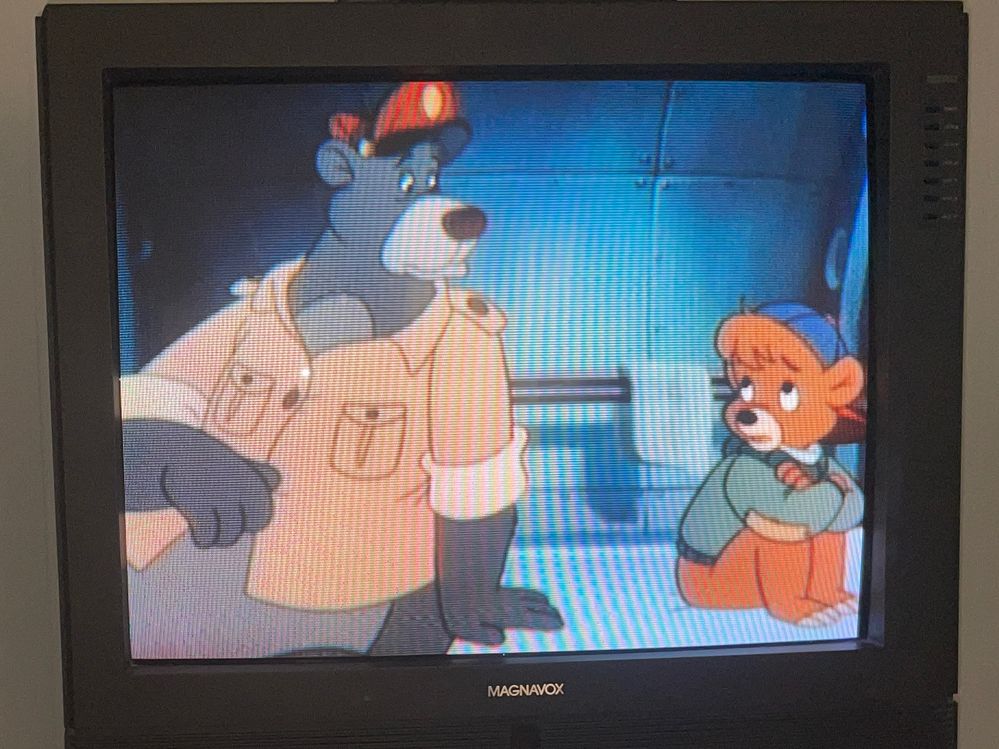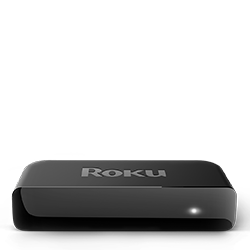Solving playback issues
- Roku Community
- :
- Streaming Players
- :
- Solving playback issues
- :
- I’m Confused about the Aspect Ratio on Disney+
- Subscribe to RSS Feed
- Mark Topic as New
- Mark Topic as Read
- Float this Topic for Current User
- Bookmark
- Subscribe
- Mute
- Printer Friendly Page
- Mark as New
- Bookmark
- Subscribe
- Mute
- Subscribe to RSS Feed
- Permalink
- Report Inappropriate Content
Alright so, I still have a Roku Express+ 3910X/3910RW (my unit is a Walmart-exclusive model FYI), which I have owned for two years, and it’s connected to my analog 4:3 CRT TV. And I have noticed something about the Disney+ app on the device.
Since my TV is 4:3, I have set the aspect ratio of my Roku device to 4:3 standard. However, some movies on Disney+ that are 4:3, including Dumbo for example, are pillar-boxed. The only other 4:3 movies that I have also tried out on Disney+ are Ichabod & Mr. Toad, Bambi, Snow White and 101 Dalmatians, those are also pillar-boxed. However, when I fast forward or rewind the movie, the PIP thing on the bottom is proper 4:3.
Does anyone have a solution to this? Or did Disney not bother coding their app to support proper 4:3? I would like to know, thank you for any responses.
- Jordan
Roku Express+ 3910X
Accepted Solutions
- Mark as New
- Bookmark
- Subscribe
- Mute
- Subscribe to RSS Feed
- Permalink
- Report Inappropriate Content
Just a guess, but I'd say Disney encoded the pillars into the video. The thumbnails don't come from the video; they're actually a separate download of JPEGs. What happens if you select 16:9 instead of 4:3 in the display settings?
Help others find this answer and click "Accept as Solution."
If you appreciate my answer, maybe give me a Kudo.
I am not a Roku employee.
- Mark as New
- Bookmark
- Subscribe
- Mute
- Subscribe to RSS Feed
- Permalink
- Report Inappropriate Content
I’ve tried out an episode of the original DuckTales TV series from 1987, and that actually streams at proper 4:3. So, it seems to me that some 4:3 content on Disney+ are pillar boxed and some are proper 4:3.
EDIT 07-08-2022: Unless I’m wrong, I’m thinking the pillarboxed 4:3 contents on Disney+ appear to be the ones upscaled to HD, with proper 4:3 content presented in the original SD quality.
~ Jordan
Roku Express+ 3910X
- Mark as New
- Bookmark
- Subscribe
- Mute
- Subscribe to RSS Feed
- Permalink
- Report Inappropriate Content
After three weeks of this thread circulating around, here is an example picture of a 4:3 original SD content displaying properly on Disney+ (and even the example picture shown is presented in 4:3!). You’re welcome.
~ Jordan 
Roku Express+ 3910X
- Mark as New
- Bookmark
- Subscribe
- Mute
- Subscribe to RSS Feed
- Permalink
- Report Inappropriate Content
Just a guess, but I'd say Disney encoded the pillars into the video. The thumbnails don't come from the video; they're actually a separate download of JPEGs. What happens if you select 16:9 instead of 4:3 in the display settings?
Help others find this answer and click "Accept as Solution."
If you appreciate my answer, maybe give me a Kudo.
I am not a Roku employee.
- Mark as New
- Bookmark
- Subscribe
- Mute
- Subscribe to RSS Feed
- Permalink
- Report Inappropriate Content
Re: I’m Confused about the Aspect Ratio on Disney+
If I select 16:9 it might squish the 16:9 signal to 4:3. To note, 16:9 is a wider ratio than 4:3, and the squished image is unfixable if the device is HDMI only and connected to an HDMI to analog conversion box. This is because most HDMI to analog converters are problematic, in terms of how the ratio or the size of the video signal is handled. Most HDMI-to-analog conversion devices are made by a minor Chinese manufacturing company called MT-Viki (formerly Maituo until 2010), and sold under many different brand-names such as AuviPal, Dingsun (formerly Dinger), Gana, Wenter, Neoteck, Ablewe, Wiistar (aka the Nintendo Rip-Off), BTS, Portta, Orei, Amazon Basics (an accessories sub-label of Amazon.com Inc.), Bleiden, TaiHuai, RuiPuo, Akale, Hall Research, Yotocap, etc. Only fewer models, most particularly from the Neoteck, Hall Research and Yotocap brands, have a zoom function and/or a 16:9/4:3 switch function. The Hall Research models are hard to find, because not only are they out of stock on Amazon, the only unit that currently circulates around eBay is sold for over $70, which seems ridiculously expensive. I have a Yotocap HDMI to analog conversion box with the zoom function (No 16:9/4:3 switch), which I use for my M2/Sega Mega Drive/Genesis Mini console, for my older TV. (Both devices, along with my Nintendo Wii-U and my Sony DVD player, are connected through a switcher, which then connects to my Sharp VCR, then to my old CRT-TV. The video signal is converted through a Sima CopyMaster/CopyThis stabilizer, as I have some DVDs with Macrovision copy-protection on them, which distorts the image.) M2 is a company that co-developed re-issues of older video games. They emulate the game visuals. The M2/Sega Mini console has the ability to correct the aspect ratio of the games on my old TV, via its "Screen Settings,” and my Yotocap conversion box zooms out the image six times, from 100% to 92% of the image. I set the zoom function to display 92% of the image, to accommodate how the image on the original Sega Mega Drive/Genesis consoles looked. (Note: The Sega Mega Drive/Genesis was first launched in 1988 in Japan as the Mega Drive, which is the name of the console internationally, and then 1989 in North America as the Genesis.) The Yotocap box was about $40 on Amazon, where my mom bought it from. The 3710 and 3910 Rokus, on the other hand, are the only streaming devices that support the good old analog CRT television sets.
~ Jordan
Roku Express+ 3910X
- Mark as New
- Bookmark
- Subscribe
- Mute
- Subscribe to RSS Feed
- Permalink
- Report Inappropriate Content
I’ve tried out an episode of the original DuckTales TV series from 1987, and that actually streams at proper 4:3. So, it seems to me that some 4:3 content on Disney+ are pillar boxed and some are proper 4:3.
EDIT 07-08-2022: Unless I’m wrong, I’m thinking the pillarboxed 4:3 contents on Disney+ appear to be the ones upscaled to HD, with proper 4:3 content presented in the original SD quality.
~ Jordan
Roku Express+ 3910X
- Mark as New
- Bookmark
- Subscribe
- Mute
- Subscribe to RSS Feed
- Permalink
- Report Inappropriate Content
After three weeks of this thread circulating around, here is an example picture of a 4:3 original SD content displaying properly on Disney+ (and even the example picture shown is presented in 4:3!). You’re welcome.
~ Jordan 
Roku Express+ 3910X
-
Audio
24 -
Audio Guide
1 -
Audio level
10 -
Audio quality
45 -
Audio settings
1 -
Audio sync
27 -
AV receiver audio-video issue
9 -
AV receiver setup
4 -
Buffering
1 -
Can't connect to network
1 -
Channel content question
1 -
Channel crash
9 -
Channel feature-functionality
2 -
Channel unavailable
1 -
Choppy audio
12 -
Choppy video
19 -
Connecting to a device
1 -
Connection issue
1 -
Crash
19 -
Device compatibility
1 -
Display settings
3 -
Expert picture settings
1 -
Features
3 -
General Playback Issue
84 -
General Question
6 -
General setup question
6 -
Google Assistant action
1 -
HDCP error
9 -
HDR
1 -
Help
4 -
Link a device
1 -
Low power
4 -
No audio
23 -
No power
9 -
No video
47 -
Overheating
6 -
Overheating warning
2 -
Play on Roku
1 -
Playback
3 -
Playback issue
8 -
Reboot
21 -
Roku TV Support
3 -
Screen mirroring
3 -
Screensaver
1 -
Search
1 -
Settings
1 -
Setup
2 -
Sign in to your account
1 -
Support
8 -
The Roku Channel on mobile
1 -
Theme
1 -
TV power and volume control
1 -
Video
4 -
Video quality
39 -
Video settings
1 -
Wireless
1
- « Previous
- Next »

